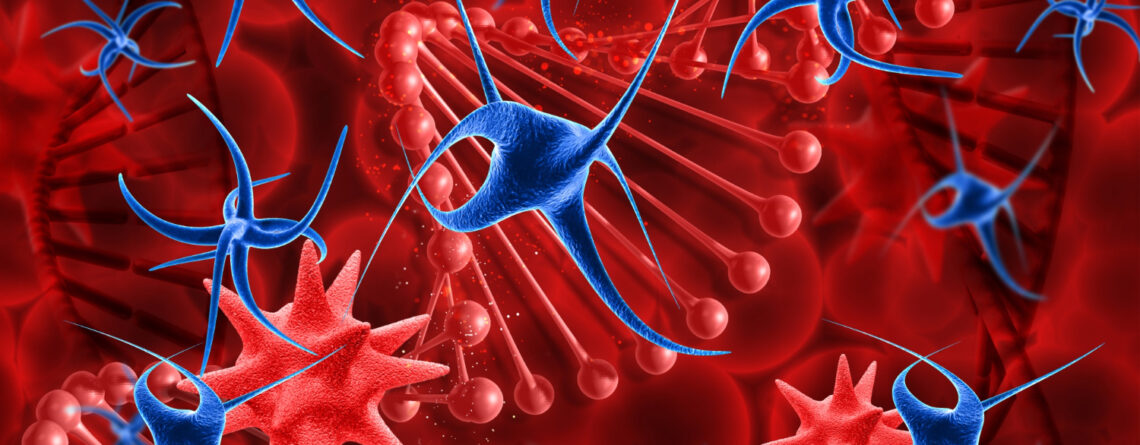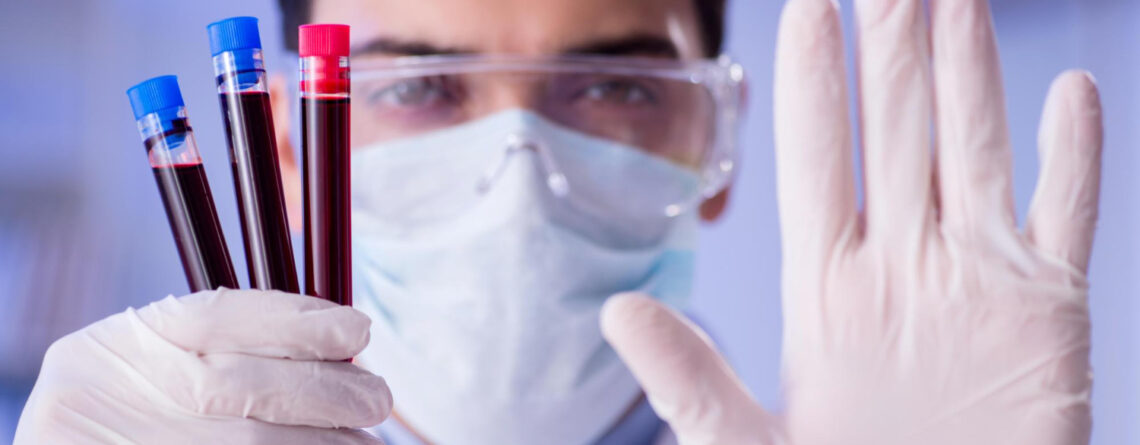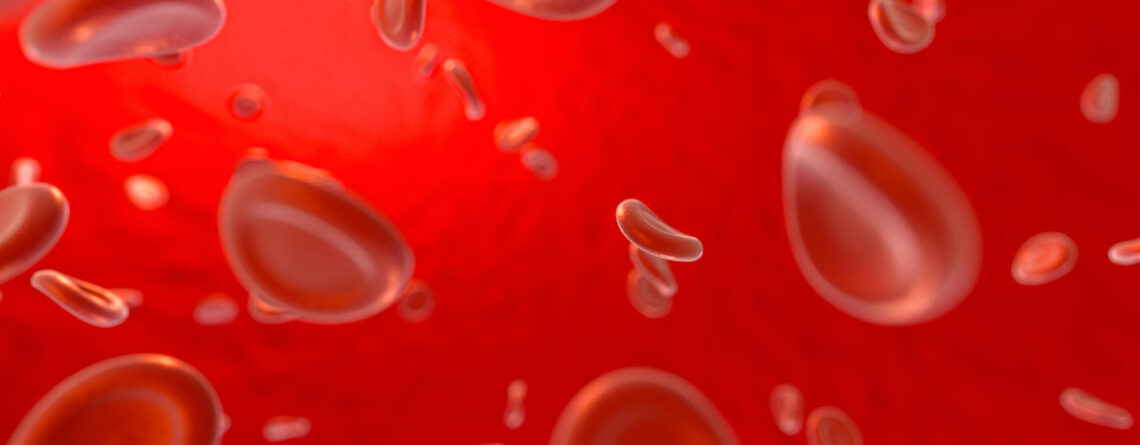Myelodysplastic syndrome (MDS) is the general name for a group of clonal hematopoietic stem cells diseases, as a result of which the body produces altered red blood cells, white blood cells, and platelets. The absence of healthy blood cells that perform important functions can cause the entire body to fail. Myelodysplastic syndrome is dangerous because over time it can transform into acute myelogenous leukemia. So it is important to detect the disease in the early stages and get the right treatment.
The risk of myelodysplastic syndrome developing increases with age. Hematologists note that in 4 out of 5 cases, the pathology occurs in patients over 60 years of age, while men are affected a little more often than women. Pathology can be asymptomatic for a long time, and in future it can become the cause of serious disturbances in the whole body functioning.

In recent years, hematologists oncologists achieved a significant success in blood system malignant diseases treatment, including MDS. Modern Hematology Oncology has achieved special development in Israel. That is why the Maimonides Multidisciplinary Medical Center chose Israeli medicine as one of the most effective in the world as a model for providing medical services. Our Hematology Department works in close and fruitful cooperation with the best oncology and hematology clinics in Israel. Each individual case of blood system malignant disease is managed jointly by the hematologist in Ukraine, the head of the department and the responsible oncology hematologist directly from Israel. Thanks to such qualified team assistance, we get encouraging results even in the most difficult cases.
The Maimonides Medical Center works under the patronage “Keren Or for our Child” the Charitable Foundation , so our patients have the opportunity to receive financial assistance for treatment.
All our hematologists in their practical activities are guided by modern clinical recommendations and global treatment protocols, so the quality of providing medical services cannot be doubted. At the same time, the approach to each patient is individual, because there are no two identical people or two identical diseases. Therefore,making up a scheme of complex treatment, the specialist takes into account all the details – age and sex, the main diagnosis, the stage of the disease, the characteristics of malignant cells, the presence of concomitant serious diseases, and patient’s e wishes about regarding treatment. Thanks to such a personalized approach, we almost always get positive treatment results.
Another myelodysplastic syndrome treatment advantage at Maimonides Medical Center is the multidisciplinary approach multidisciplinary approach to each individual clinical case. The patient is assisted not only by hematologists, but also by oncologists, chemotherapists, radiation therapists, surgeons, psychologists, rehabilitators, infectious disease specialists, hepatologists, physical therapists, and many other specialized specialists if necessary. In this way, the patient can receive the entire range of necessary medical services, starting with diagnosis and ending with complex treatment and recovery after it, within the walls of one medical institution. This improves compliance and has a positive impact on long-term results.
Our medical center uses only modern and safe medical and diagnostic equipment of expert class If a certain narrow specialist or rare medical and diagnostic equipment is not available, patient is referred to subsidiary institutions of Maimonides Medical Center or our Israeli partner clinics , where he is guaranteed to receive the full range of necessary medical services.

Myelodysplastic syndrome causes and types
In most cases, myelodysplastic syndrome develops without any reason. It is known that certain diseases can increase the risk of MDS. These include Down syndrome, Fanconi anemia, neurofibromatosis and some others.
Primary MDS (idiopathic) is distinguished – 80-90% of all MDS cases, the cause of which is unknown, and secondary MDS (10-20%) occurs after previous chemotherapy and the negative impact of some other factors.
Secondary MDS has a significantly worse prognosis and is often resistant to treatment. 10-20% of MDS cases arise as a result of previous chemotherapy for other neoplasms. Among drugs that have a proven ability to cause MDS development are Alkylating agents (cyclophosphane), topoisomerase inhibitors – antitumor agents of plant origin (topotecan, irinotecan, etc.), anthracyclines (doxorubicin) and podoxorubicin. Radiation therapy and prolonged contact with toxic materials can lead to MDS.
Potential risk factors for primary MDS:
- Contact with certain chemicals (gasoline, organic solvents, including benzene, pesticides).
- The influence of radiation.
- smoking.
- Some congenital and hereditary diseases.
- Older age.
Risk factors for secondary MDS:
- Previous cancer chemotherapy or after TCM.
Transformation of myelodysplastic syndrome into acute myeloid leukemia occurs in 30% of cases.
Types of myelodysplastic syndromes:
- Refractory anemia.
- Refractory anemia with annular sideroblasts.
- Refractory cytopenia with multilineage dysplasia.
- Refractory cytopenia with multilineage dysplasia and ring sideroblasts.
- Refractory anemia with blasts excess.
- Unclassified myelodysplastic syndrome.
- MDS with isolated 5q deletion.
- Chronic myelomonocytic leukemia and juvenile myelomonocytic leukemia.
- Chronic neutrophilic leukemia.
Accurate type pathology determination makes it possible to choose the appropriate therapy and form the prognosis.
Myelodysplastic syndrome symptoms
Symptoms of myelodysplastic syndrome depend on changes in the blood test and disease course features. With a mild form, the pathology does not manifest itself for a long time and is revealed, as a rule, by chance only during a general blood test. With a significant deficiency of certain cells, the patient may complain of following problems:
- Anemia – the content of hemoglobin and erythrocytes in the blood drops. It is accompanied by weakness, breath shortness with minimal physical exertion, frequent dizziness and fainting, skin pallor, increased heartbeat, hair loss, etc.
- Thrombocytopenia and hemorrhagic syndrome. Appears blood coagulation disorders associated with a lack of platelets; a person complains of frequent bleeding from nose and gums, bruises and spot hemorrhages on the skin, in women, the duration and intensity of menstrual bleeding increases.
- Leukopenia and associated infectious complications. As a result of leukocytes decrease (most often – neutrophils) in blood, there is a significant immunity decrease. As a result SARS increase in the frequency and severity, frequent inflammations of mucous membranes and skin, and risk of pneumonia developing is also higher, sinusitis, sepsis and other inflammatory bacterial diseases.
- One of the classic symptoms of myelodysplastic syndrome is enlargement of the lymph nodes, liver and spleen.

Myelodysplastic syndrome diagnosis methods
As you know, the earlier the diagnosis of a malignant disease is established, the better prognosis and treatment result. Therefore, high-quality and quick diagnosis is an extremely important stage. Maimonides Medical Center uses only modern, expert-class equipment, all our doctors perfectly master all methods of examining patients with suspected MDS, and are able to accurately interpret received data. All of this helps them to create modern, individual and effective treatment plan.
The main method of myelodysplastic syndrome diagnosing is a blood test. With MDS, it is possible to decrease both one indicator and their combination. The diagnosis is made only for persistent (at least six months) cytopenia, if no other reasons are found.
If myelodysplastic syndrome is suspected, trepan biopsy and bone marrow puncture are provided. The obtained biomaterial is sent for histological and cytological examination.
We send all materials after the biopsy to the world's best pathogistological laboratories (Israel, Germany, USA).Thanks to such double checks, we are absolutely sure of diagnosis correctness and effectiveness of the selected treatment tactics.
Our patients also have access to innovative molecular diagnostics of biopsy specimens of material after biopsy (molecular genetic studies). This is an obligatory part of oncological diseases modern diagnosis. As is known, the direct cause of many tumors is a mutation in a certain gene. Thanks to molecular genetic diagnostics, we can find these mutations and choose the most effective treatment regimens, because the response to the effect of certain drugs depends on the type of changes. An example of such modern diagnostics is test systems for molecular genetic testing, like Foundation One and Caris Molecular Testing .
To rule out other causes of cytopenia, the patient is referred for additional laboratory and instrumental studies.
Cytopenia accompanies various diseases. Therefore, it is important to exclude the following causes: malignant neoplasms, autoimmune diseases, chronic infections, hematopoietic disorders, gasoline or heavy metal poisoning, copper deficiency, excess zinc, side effects of drugs, etc.
All necessary diagnostic procedures can be performed directly in the clinic, without leaving Ukraine.

Myelodysplastic syndrome modern treatment
One of the most important advantages of malignant blood diseases treatment at Maimonides Medical Center is the application of a comprehensive approach to each individual clinical case. In struggle against the disease, the doctor uses the entire available arsenal of methods. Therapy is always a combination of two, three, or even more methods. As a rule, the treatment regimen includes systemic drug chemotherapy in combination with radiation therapy and hematopoietic stem cell transplantation. In some cases, certain innovative methods of treatment are added to the treatment program (targeted drugs, immunobiological drugs, etc.).
Not all MDS cases require intensive treatment. In general, therapy is prescribed only for patients with severe symptoms of the disease.
Clinically symptomatic patients usually require ongoing blood and platelet transfusions.
Erythropoiesis-stimulating agents (ESAs) reduce the degree of anemia in 15–20% of patients with MDS. In refractory anemia with annular sideroblasts, treatment with erythropoiesis-stimulating agents , as well as with granulocyte colony-stimulating factor (GCSF) , can increase the response to treatment by up to 40%. However, in all forms of MDS, treatment with growth factors (ESS + GCSF) does not increase survival and/or does not reduce the risk of transformation into myeloid leukemia.
Chemotherapy is actively used in treatment of patients with MDS. There are 3 main treatment methods:
- High-dose chemotherapy, including stem cell transplantation and polychemotherapy. It is prescribed to patients belonging to the group of high or intermediate risk. During chemotherapeutic treatment, epigenetic modulators Azacitidine and Decitabine are used (alleviate symptoms, prevent transition to acute myeloid leukemia), immunomodulator lenalidomide.
- Low-dose chemotherapy in combination with replacement and immunosuppressive therapy. It is provided at a low and intermediate risk of MDS transformation into acute leukemia.
- Symptomatic and supportive treatment. Allows to improve the quality of life and increase its duration.
Allogeneic hematopoietic stem cells transplantation is the only method of radical myelodysplastic syndrome treatment. Allogeneic hematopoietic stem cells transplantation is indicated for younger and healthier patients from a medical point of view. All other methods are aimed at reducing the manifestations of pathological symptoms, preventing complications, and improving the quality of life. But due to the high risk of complications, including the possibility of death, and the lack of donors, only 5-10% of patients offer transplantation. Usually, stem cell transplantation is recommended for patients younger than 65 years of age with intermediate and high risk of MDS transformation into acute leukemia if a suitable donor present.
Before the bone marrow transplantation, the patient must undergo high-dose chemotherapy to destroy all malignant cells. A feature of this treatment is large doses of drugs, which kill not only all malignant cells, but also healthy bone marrow cells. Therefore, during this period (between chemotherapy, the direct grafting procedure and the time of new bone marrow engraftment), the body becomes completely defenseless against any infection. That is why it is so important to follow all the rules of infection control to minimize the risk of infection, the patient is placed in a sterile box during this period. In our clinic, the patient will be provided with all the necessary conditions for a quick recovery after the procedure.
After treatment , the patient undergoes a recovery course in the clinic's rehabilitation center under the supervision of high-level rehabilitation specialists. This significantly improves the prognosis and reduces long-term side effects from therapy. In each individual case, the decision about certain treatment methods combination is made jointly by a team of specialists.
In each individual case, the decision on the combination of certain treatment methods is made jointly by a team of specialists. Each person and their disease is different, so our doctors, relying on their experience in myelodysplastic syndromes treatment , often go beyond the standard protocols, changing treatment regimens and doses of the necessary drugs in order to obtain the best possible results for their patients.
